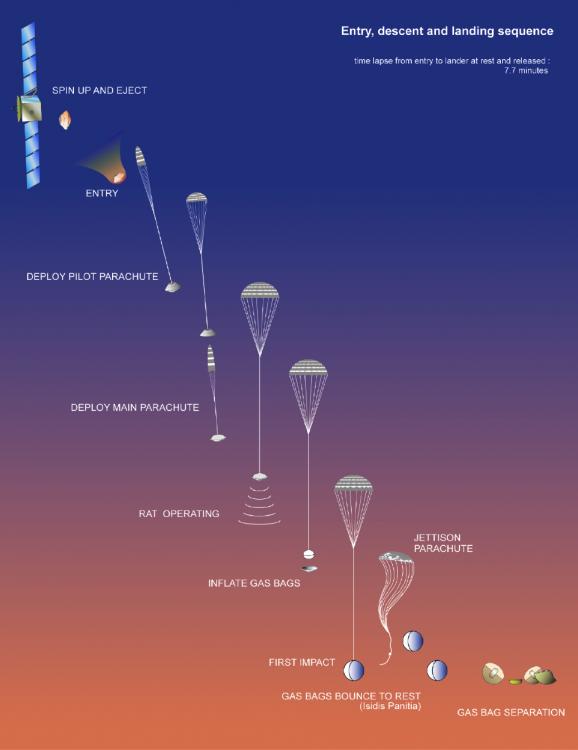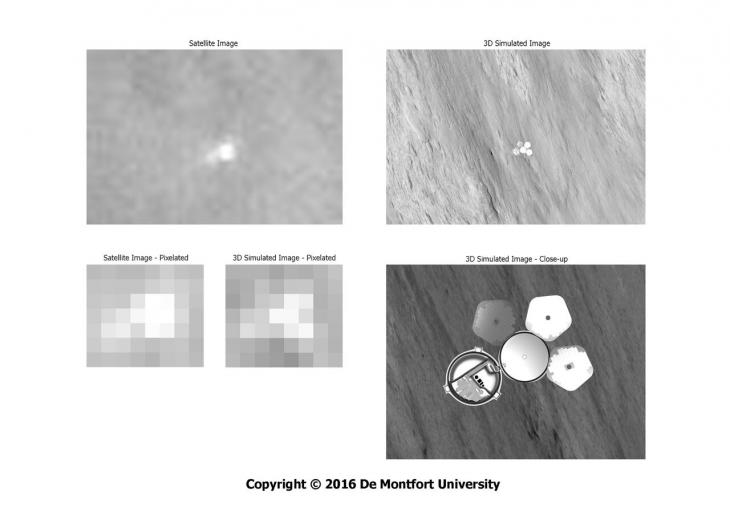.
Researchers use novel analysis technique to help solve Beagle 2 mystery
Issued by University of Leicester Press Office on 10 November 2016
‘We are delighted to say that we have gone way beyond the original plan to reach this exciting conclusion that Beagle 2 did not crash, but landed and probably deployed most of its panels. Hopefully these results help to solve a long held mystery and will benefit any future missions to Mars.’- Nick Higgett, De Montfort University
‘This unique University collaboration between space scientists and digital designers allowed the reflection analysis concept to be put into practice and tested and ultimately produce these exciting results,’ - Professor Mark Sims, University of Leicester
Images using new analysis technique and archive imagery of Beagle 2 available to download from: https://www.dropbox.com/sh/3f0jtpnl0q9elqi/AADNoZ27_C8KZMBrL6UymBERa?dl=0



Archive video for Beagle 2 mission (Animations credit as: ‘All Rights Reserved Beagle 2’): https://www.dropbox.com/sh/n0yh64po8b4q7gd/AABNqqpuyuJENDgiTVtqleLRa?dl=0
Watch or embed a video interview with Professor Mark Sims about finding Beagle 2:
https://www.youtube.com/watch?v=iAKAJR4N6zQ
Scientists in Leicester have moved one step closer to understanding exactly what happened to the ill-fated Mars Lander Beagle 2, thanks to an innovative research technique.
The probe was discovered on the Red Planet in November 2014 but uncertainty surrounded what had caused its failure to communicate with Earth.
Now, a collaboration between De Montfort University and the University of Leicester, has used 3D modelling technology to reveal for the first time that Beagle 2 deployed at least three, and possibly all four, of the solar panels it was supposed to after touching down on the planet’s surface.
The finding will rewrite scientific knowledge about the stricken Lander – it was previously thought that perhaps only (as few as) two of the four solar panels had deployed.
Beagle 2 was part of the ESA Mars Express Mission launched in June 2003. Mars Express is still orbiting Mars and returning scientific data on the planet. Beagle 2 was successfully ejected from ESA’s Mars Express spacecraft on 19 December 2003 but failed to send a signal on Christmas Day - its scheduled landing day on Mars. It was presumed lost until over a decade later when the mystery of what happened to the mission was solved through images taken by NASA’s Mars Reconnaissance Orbiter (MRO).
Despite its detection, due to the small size of the lander and the resolution of the HiRISE camera on the MRO, the exact configuration of the lander on Mars was not clear - despite collection of 8 images of the lander and use of advanced image processing techniques.
Now the researchers from De Montfort University and the University of Leicester have worked together to come up with a new way to detect the configuration of the lander.
Professor Mark Sims, former Beagle 2 Mission Manager and Professor of Astrobiology and Space Instrumentation at the University of Leicester came up with the concept of “reflection analysis” - of matching simulated and real images of Beagle 2.
The technique is based on simulating possible configurations of the lander on the surface and comparing the light of the Sun reflected by the simulated lander with the unprocessed images available from the HiRISE camera at a number of different sun angles.
Professor Sims turned to a team at De Montfort University to realise his concept. Commercially available software used for 3D modelling, animation, visual effects and simulation design was adapted to enable this analysis.
Nick Higgett leader of the De Montfort University Simulation team said: “This has been an exciting collaboration with the University of Leicester’s Space Research Centre. The De Montfort team were responsible for all the 3D simulation work to test the reflection analysis concept. In order to do this, our visualisation specialist Teodora Kuzmanova had to create a physically accurate 3D model of the Beagle 2 Mars Lander with surfaces that would accurately reflect virtual sunlight. The angle of the sun had to be simulated along with position of a virtual camera that could take pictures equivalent to NASA’s Reconnaissance Orbiter. Finally these images had to be pixelated to match the resolution of the Orbiter’s images.
“The visual comparison between the real and simulated images could then begin to identify which landing configuration (1, 2, 3 or 4 deployed solar panels) was the best fit. This was originally a proof of principle project. However, we are delighted to say that we have gone way beyond this original plan to reach this exciting conclusion that Beagle 2 did not crash but landed and probably deployed most of its panels. Hopefully these results help to solve a long held mystery and will benefit any future missions to Mars.”
Professor Mark Sims added: “Although the concept of the “reflection analysis” was mine I didn’t know it would work. Thanks to the effort of the team at De Montfort University they proved that this concept could work and we have gathered more information on the failure of Beagle 2 to communicate and we are one step closer to knowing what happened. In reality we may of course never know exactly what caused its failure to communicate after what has been confirmed as a successful landing, which was a fantastic achievement by the Beagle 2 team. The work shows frustratingly that Beagle 2 came so close to working as intended on Mars.
“This unique University collaboration between space scientists and digital designers allowed this reflection analysis concept to be put into practice and tested and ultimately produce these exciting results.”
Nick Higgett, leader of the MA Digital Design group at DMU, together with 3D specialists Teadora Kuzmanova and Dr Eric Tatham, used 3D software to model the scene in three dimensions, adjusting the position of the sun and the resting angle and orientation of the Beagle 2, unfolding the four solar panels at different angles taking in the illumination conditions on the planet until they found the best visual match to what the NASA original images showed. These simulations were then adjusted to reproduce the resolution and view point of the NASA spacecraft.
Mark Sims, Professor of Astrobiology and Space Instrumentation at the University of Leicester (UL), former Beagle 2 Mission Manager who derived the concept and Dr Jim Clemmet, former Beagle 2 Chief Engineer, advised the DMU team on the technical details of the lander and Mars. Professor Sims and colleagues at UL compared the images (simulated and real) at a detailed level and derived the close matches.
This work confirmed that antenna transmission would probably have been hampered by one of the panels failing to unfold correctly, confirming the previously supposed theory.
Mr Higgett said it was as close to a definitive explanation as would be possible without landing on the planet itself.
The best match four panel configuration is at a different tilt angle - in terms of angle of the panels with respect to the lid of Beagle 2 - from the 3 panel configuration. This analysis also confirms that the Beagle 2 front heat shield has been detected on Mars and its configuration and orientation is now also known. This work contributes further information to the analysis of why Beagle 2 failed to transmit from the surface of Mars and complements other techniques such as super-resolution imaging as conducted by Professor Jan-Peter Muller and his team at University College London announced in April 2016.
The researchers, who plan to publish their findings, add: “The current analysis is we believe fully consistent with this other work which combines data from all the different sun angles.
“This work (further) confirms that the Entry, Descent and Landing (EDL) sequence for Beagle 2 worked as expected and the lander did successfully touchdown on Mars on Christmas Day 2003.
“However, for an as yet unconfirmed and undetected reason it failed to communicate following landing, although incomplete deployment for an unknown reason continues to be the likely primary cause, particularly in the case of three panel deployment where the RF antenna would be unable to transmit through the fourth un-deployed panel.”
The scientists add that the “reflection analysis” technique used for this research could find applications in other fields where an illumination source is present and the target has a limited set of configurations and is highly reflective in nature. “Further analysis of the Beagle 2 images using the technique, subject to additional funding and ideally other images at a variety of sun angles, might further define the configuration of the 1st UK ESA lander to land on Mars,” they state.
Beagle 2, a collaboration between industry and academia, would have delivered world-class science from the surface of the Red Planet. Many UK academic groups and industrial companies contributed to Beagle 2. Professor Colin Pillinger from the Open University who led the Beagle 2 project with inspirational enthusiasm died in May 2014 before the fate of the lander was revealed. Others who also died in 2014 and provided major contributions to Beagle 2 were Professor George Fraser of the University of Leicester and Professor David Barnes of Aberystwyth University.
The work was enabled by HEFCE Higher Education Innovation Funding (HEIF) from De Montfort University, which provided the resources for the simulation work. The De Montfort simulation team was led by Nick Higgett, assisted by 3D visualisation specialist Dr Eric Tatham. The 3D computer model of Beagle 2 and satellite image simulations were produced by Teodora Kuzmanova. Dr Jim Clemmet former chief engineer on Beagle 2 advised on the likely and possible configurations of the lander. “Out of hours” private research time was used by members of the University of Leicester. Professor Mark Sims of the University of Leicester and former Beagle 2 Mission Manager derived the concept of the “reflection analysis” used in this work and helped to guide the work. Detailed analysis of the images and their match was performed by Dr Sarah Bugby and Alex Smyth at the University of Leicester and Dr Derek Pullan advised on the data available via the MRO HiRISE camera.
Further details of this work are available from a dedicated web site at De Montfort University, see http://beagle2.our.dmu.ac.uk/
Quelle: University of Leicester
